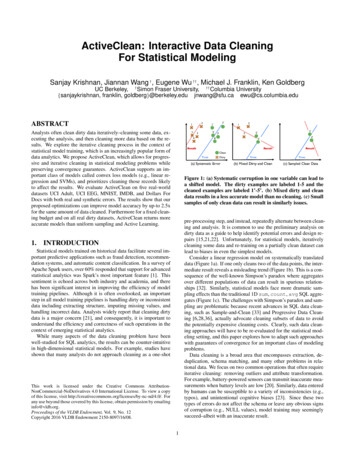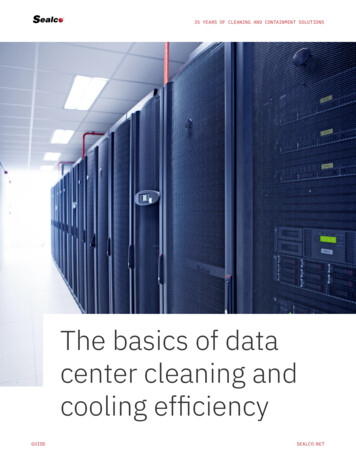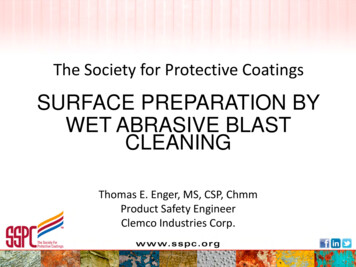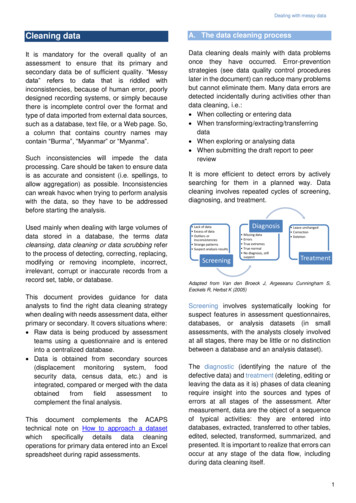
Transcription
ActiveClean: Interactive Data CleaningFor Statistical ModelingSanjay Krishnan, Jiannan Wang † , Eugene Wu †† , Michael J. Franklin, Ken GoldbergUC Berkeley,†Simon Fraser University, †† Columbia Universityjnwang@sfu.ca ewu@cs.columbia.edu{sanjaykrishnan, franklin, goldberg}@berkeley.eduABSTRACTAnalysts often clean dirty data iteratively–cleaning some data, executing the analysis, and then cleaning more data based on the results. We explore the iterative cleaning process in the context ofstatistical model training, which is an increasingly popular form ofdata analytics. We propose ActiveClean, which allows for progressive and iterative cleaning in statistical modeling problems whilepreserving convergence guarantees. ActiveClean supports an important class of models called convex loss models (e.g., linear regression and SVMs), and prioritizes cleaning those records likelyto affect the results. We evaluate ActiveClean on five real-worlddatasets UCI Adult, UCI EEG, MNIST, IMDB, and Dollars ForDocs with both real and synthetic errors. The results show that ourproposed optimizations can improve model accuracy by up-to 2.5xfor the same amount of data cleaned. Furthermore for a fixed cleaning budget and on all real dirty datasets, ActiveClean returns moreaccurate models than uniform sampling and Active Learning.1.Figure 1: (a) Systematic corruption in one variable can lead toa shifted model. The dirty examples are labeled 1-5 and thecleaned examples are labeled 1’-5’. (b) Mixed dirty and cleandata results in a less accurate model than no cleaning. (c) Smallsamples of only clean data can result in similarly issues.pre-processing step, and instead, repeatedly alternate between cleaning and analysis. It is common to use the preliminary analysis ondirty data as a guide to help identify potential errors and design repairs [15,21,22]. Unfortunately, for statistical models, iterativelycleaning some data and re-training on a partially clean dataset canlead to biases in even the simplest models.Consider a linear regression model on systematically translateddata (Figure 1a). If one only cleans two of the data points, the intermediate result reveals a misleading trend (Figure 1b). This is a consequence of the well-known Simpson’s paradox where aggregatesover different populations of data can result in spurious relationships [32]. Similarly, statistical models face more dramatic sampling effects than the traditional 1D sum, count, avg SQL aggregates (Figure 1c). The challenges with Simpson’s paradox and sampling are problematic because recent advances in SQL data cleaning, such as Sample-and-Clean [33] and Progressive Data Cleaning [6,28,36], actually advocate cleaning subsets of data to avoidthe potentially expensive cleaning costs. Clearly, such data cleaning approaches will have to be re-evaluated for the statistical modeling setting, and this paper explores how to adapt such approacheswith guarantees of convergence for an important class of modelingproblems.Data cleaning is a broad area that encompasses extraction, deduplication, schema matching, and many other problems in relational data. We focus on two common operations that often requireiterative cleaning: removing outliers and attribute transformation.For example, battery-powered sensors can transmit inaccurate measurements when battery levels are low [20]. Similarly, data enteredby humans can be susceptible to a variety of inconsistencies (e.g.,typos), and unintentional cognitive biases [23]. Since these twotypes of errors do not affect the schema or leave any obvious signsof corruption (e.g., NULL values), model training may seeminglysucceed–albeit with an inaccurate result.INTRODUCTIONStatistical models trained on historical data facilitate several important predictive applications such as fraud detection, recommendation systems, and automatic content classification. In a survey ofApache Spark users, over 60% responded that support for advancedstatistical analytics was Spark’s most important feature [1]. Thissentiment is echoed across both industry and academia, and therehas been significant interest in improving the efficiency of modeltraining pipelines. Although it is often overlooked, an importantstep in all model training pipelines is handling dirty or inconsistentdata including extracting structure, imputing missing values, andhandling incorrect data. Analysts widely report that cleaning dirtydata is a major concern [21], and consequently, it is important tounderstand the efficiency and correctness of such operations in thecontext of emerging statistical analytics.While many aspects of the data cleaning problem have beenwell-studied for SQL analytics, the results can be counter-intuitivein high-dimensional statistical models. For example, studies haveshown that many analysts do not approach cleaning as a one-shotThis work is licensed under the Creative Commons AttributionNonCommercial-NoDerivatives 4.0 International License. To view a copyof this license, visit http://creativecommons.org/licenses/by-nc-nd/4.0/. Forany use beyond those covered by this license, obtain permission by emailinginfo@vldb.org.Proceedings of the VLDB Endowment, Vol. 9, No. 12Copyright 2016 VLDB Endowment 2150-8097/16/08.1
We propose ActiveClean, a model training framework that allows for iterative data cleaning while preserving provable convergence properties. The analyst initializes ActiveClean with a model,a featurization function, and a pointer to a dirty relational table. Ineach iteration, ActiveClean suggests a sample of data to clean basedon the data’s value to the model and the likelihood that it is actuallydirty. The analyst can apply value transformations and filtering operations to the sample. ActiveClean will incrementally and safelyupdate the current model (as opposed to complete re-training). Wepropose several novel optimizations that leverage information fromthe model to guide data cleaning towards the records most likely tobe dirty and most likely to affect the results.From a statistical perspective, our key insight is to treat the cleaning and training iteration as a form of Stochastic Gradient Descent,an iterative optimization method. We treat the dirty model as an initialization, and incrementally take gradient steps (cleaning a sampleof records) towards the global solution (i.e., the clean model). Ouralgorithm ensures global convergence with a provable rate for animportant class of models called convex-loss models which includeSVMs, Linear Regression, and Logistic Regression. Convexity isa property that ensures that the iterative optimization converges toa true global optimum, and we can apply convergence argumentsfrom convex optimization theory to show that ActiveClean converges.To summarize our contributions:The dataset comes with a status field that describes whether ornot the donation was allowed under the declared research protocol.Unfortunately the dataset is dirty, and there are inconsistent waysto specify “allowed” or “disallowed”. The ProPublica team identified the suspicious donations via extensive manual review (documented in [2]). However, new donation datasets are continuouslyreleased and would need to be analyzed by hand. Thus, let us consider an alternative ActiveClean-based approach to train a model topredict the true status value. This is necessary for several reasons: 1) training a model on the raw data would not work becausethe status field is often inconsistent and incorrect; 2) techniquessuch as active learning are only designed for acquiring new labelsand not suitable for finding and fixing incorrect labels; and 3) otherattributes such as company name may also be inconsistent (e.g.,Pfizer Inc., Pfizer Incorporated, Pfizer) and need to be canonicalized before they are useful for training the model.During our analysis, we found that nearly 40,000 of the 250,000records had some form of inconsistency. Indeed, these errors werestructural rather than random—disallowed donations were morelikely to have an incorrect status value. In addition, larger pharmaceutical comparies were more likely to have inconsistent names,and more likely to make disallowed donations. Without cleaningcompany names, a model would miss-predict many large pharmaceutical donations. In fact, we found that the true positive rate forpredicting disallowed donations when training an SVM model onthe raw data was only 66%. In contrast, cleaning the entire datasetimproves this rate to 97% (Section 7.2.2), and we show in the experiments that ActiveClean can achieve comparable model accuracy (¡ 1% of the true model accuracy) while expending only 10%of the data cleaning effort. The rest of this section will introduce thekey challenges in designing a Machine-Learning-oriented iterativedata cleaning framework. We propose ActiveClean, which allows for progressive datacleaning and statistical model training with guarantees. Correctness We show how to update a dirty model givennewly cleaned data. This update converges monotonically inexpectation with a with rate O( 1T ). Optimizations We derive a theoretically optimal samplingdistribution that minimizes the update error and an approximation to estimate the theoretical optimum. We further showthat ActiveClean can integrate with existing dirty data detection techniques. Our proposed optimizations can improvemodel accuracy by up-to 2.5x for the same amount of datacleaned. Experiments The experiments evaluate ActiveClean on fivedatasets with real and synthetic corruption. In a fraud prediction example, ActiveClean examines nearly 10x less recordsthan alternatives to achieve an 80% true positive rate.2.2The correctness of many of the components detailed proofs, whichwe have included in our extended technical report [24].2.ITERATIVE DATA CLEANINGThis section introduces the problem of iterative data cleaningthrough an example application.2.1Iteration in Model ConstructionConsider an analyst designing a classifier for this dataset. Whenshe first develops her model on the dirty data, she will find that thedetection rate (true positives predicted) is quite low 66%. To investigate why she might examine those records that are incorrectlypredicted by the classifier.It is common for analysts to use the preliminary analysis ondirty data as a guide to help identify potential errors and designrepairs [21]. For example, our analyst may discover that there arenumerous examples where two records are nearly identical, but oneis predicted correctly, and one is incorrect, and their only differenceis the corporation attribute: Pfizer and Pfizer Incorporated.Upon discovering such inconsistencies, she will merge those twoattribute values, re-train the model, and repeat this process.We define iterative data cleaning to be the process of cleaningsubsets of data, evaluating preliminary results, and then cleaningmore data as necessary. ActiveClean explores two key questionsabout this iterative process: (1) Correctness. Will this clean-retrainloop converge to the intended result and (2) Efficiency. How canwe best make use of the existing data and analyst effort.Use Case: Dollars for DocsProPublica collected a dataset of corporate donations to medicalresearchers to analyze conflicts of interest [4]. For reference, thedataset has the following schema:Correctness: The straight-forward application of data cleaning isto repair the corruption in-place, and re-train the model after eachrepair. However, this process has a crucial flaw, where a model istrained on a mix of clean and dirty data. It is known that aggregatesover mixtures of different populations of data can result in spuriousrelationships due to the well-known phenomenon called Simpson’sparadox [32]. Simpson’s paradox is by no means a corner case, andit has affected the validity of a number of high-profile studies [29].Figure 1 illustrates a simple example where such a process can leadto unreliable results, where artificial trends introduced by the mix-Contribution(pi specialty text, # PI’s medical specialtydrug nm text , # drug brand name, null if not drugdevice nm text, # device brand name, null if not a devicecorp text,# name of pharamceutical donoramount float,# amount donateddispute bool,# whether the research is disputedstatus text# if the donation is allowed# under research protocol)2
the same schema or remove the record C(r). ActiveCleanis agnostic to how C(·) is implemented, e.g., with software or amanual action by the analyst. We define the clean relation as arelation of all of the records after cleaning:Rclean Ni C(ri R)ture can be confused for the effects of data cleaning. The consequence is that after applying a data cleaning operation on a subsetof data the analyst cannot be sure if it makes the model more or lessaccurate. ActiveClean provides an update algorithm with a monotone convergence guarantee where more cleaning is leads to a moreaccurate result in expectation.Therefore, for every r0 Rclean there exists a unique r R in thedirty data. Supported cleaning operations include merging common inconsistencies (e.g., merging “U.S.A” and “United States”),filtering outliers (e.g., removing records with values 1e6), andstandardizing attribute semantics (e.g., “1.2 miles” and “1.93 km”).Our technical report discusses a generalization of this basic datacleaning model called the “set of records” cleaning model [24]. Inthis generalization, the C(·) function is composed of schema preserving map and filter operations applied to the entire dataset. Thiscan model problems such batch merging of inconsistencies with a“find-and-replace”. We acknowledge that both definitions of datacleaning are limited as they do not cover errors that simultaneouslyaffect multiple records such as record duplication or structure suchas schema transformation.Efficiency: One could alternatively avoid the mixing problemby taking a small sample of data up-front, perfectly cleaning it,and then training a model. This approach is similar to SampleClean [33], which was proposed to approximate the results of aggregate queries by applying them to a clean sample of data. However, high-dimensional models are highly sensitive to sample size,and it is not uncommon to have models whose training data complexity is exponential in the dimensionality (i.e., the curse of dimensionality). Figure 1c illustrates that, even in two dimensions,models trained from small samples can be as incorrect as the mixing solution described before. Sampling further has a problem ofscarcity, where errors that are rare may not show up in the sample.ActiveClean uses a model trained on the dirty data as an initialization and uses this model as guide to identify future data to clean.3.2Comparison to Active Learning: The motivation of ActiveCleansimilar to that of Active Learning [17,36] as both seek to reducethe number of queries to an analyst or a crowd. However, activelearning addresses a fundamentally different problem than ActiveClean. Active Learning poses the problem of iteratively selectingthe most informative unlabeled examples to label in partially labeled datasets—these examples are labeled by an expert and integrated into the machine learning model. Note that active learningdoes not handle cases where the dataset is labelled incorrectly butonly cases where labels are missing. In contrast, ActiveClean studies the problem of prioritizing modifications to both features andlabels in existing examples. In essence, ActiveClean handles incorrect values in any part (label or feature) of an example. Thisproperty changes the type of analysis and algorithms that can beused. Consequently, our experiments find that general active learning approaches (e.g., uncertainty sampling [31]) converge slowerthan ActiveClean. If the only form of data error was missing labels, then we would expect active learning to perform comparablyor better than ActiveClean.3.Clean Model: θ(c) is the optimal clean model, i.e., the modeltrained on a fully cleaned relation. Accuracy and convergence arealways with respect to θ(c) .Current Model: θ(t) is the current best model at iteration t {1, ., kb }, and θ(0) θ(d) .PROBLEM FORMALIZATION3.3ActiveClean is an iterative framework for cleaning data in support of statistical modeling. Analysts clean batches of data, whichare fed back into the system to intelligently re-train the model, andrecommend a next batch of data to clean. We will first introducethe terms used in the rest of the paper, describe our assumptions,and define the two problems that we solve in this paper.3.1NotationThe user provides a pointer to a dirty relation R, a cleaner C(·), afeaturizer F (·), and a convex loss problem. A total of k records willbe cleaned in batches of size b, so there will be T kb iterations ofthe algorithm. We use the following notation to represent relevantquantities:Dirty Model: θ(d) is the model trained on R (without cleaning).Dirty Records: Rdirty R is the subset of records that are stilldirty. As more data are cleaned Rdirty {}.Clean Records: Rclean R is the subset of records that areclean, i.e., the complement of Rdirty .Batches: S is a batch of data (possibly selected stochastically butwith known probabilities) from the records Rdirty . The clean batchis denoted by Sclean C(S).System ArchitectureThe main insight of ActiveClean is to model the interactive datacleaning problem as Stochastic Gradient Descent (SGD) [9]. SGDis an iterative optimization algorithm that starts with an initial estimate and then takes a sequence of steps “downhill” to minimizean objective function. Similarly, in interactive data cleaning, thehuman starts with a dirty model and makes a series of cleaningdecisions to improve the accuracy of the model. We formalize thelink between these two processes, and since SGD is one of the mostwidely studied forms of optimization, it has well understood theoretical convergence conditions. These theoretical properties giveus clear restrictions on different components. Figure 2 illustratesthe ActiveClean architecture including the: Sampler, Cleaner, Updater, Detector, and Estimator.The first step of ActiveClean is initialization. We first initializeRdirty R and Rclean . The system first trains the modelon Rdirty to find an initial model θ(d) that the system will subsequently improve iteratively. It turns out that SGD converges foran arbitrary initialization, so θ(d) need not be very accurate. Thiscan be done by featurizing the dirty records (e.g., using an arbitraryplaceholder for missing values), and then training the model.AssumptionsIn this paper, we use the term statistical modeling to describe awell-studied class of analytics problems; ones that can be expressedas the minimization of convex loss functions. Examples include linear models (including linear and logistic regression), support vectormachines, and in fact, means and medians are also special cases.This class is restricted to supervised Machine Learning, and the result of the minimization is a vector of parameters θ. We furtherassume that there is a one-to-one mapping between records in arelation R and labeled training examples (xi , yi ).ActiveClean considers data cleaning operations that are appliedrecord-by-record. That is, the data cleaning can be represented as auser-defined function C(·) that when applied to a record r and canperform two actions: recover a unique clean record r0 C(r) with3
Prioritization Problem: The prioritization problem is to selectSclean in such a way that the model converges in the fewest iterations possible. Formally, in each batch of data, every r has aprobability p(r) of being included. The Prioritization Problem is toselect a sampling distribution p(·) to maximize the progress madewhich each iteration of the update algorithm. We derive the optimalsampling distribution for the updates, and show how the theoreticaloptimum can be approximated, while still preserving convergence.Figure 2: ActiveClean allows users to train predictive models while progressively cleaning data but preserves convergenceguarantees. Solid boxes are essential components for correctness and dotted boxes indicate optimizations that can improvemodel accuracy by up-to 2.5x (Section 7.4.2)4.In the next step, the Sampler selects a batch of data S from thedata that has not been cleaned already. To ensure convergence, theSampler has to do this in a randomized way, but can assign higherprobabilities to some data as long as no data has a zero samplingprobability. The Cleaner is user-specified and executes C(·) foreach sample record and outputs their cleaned versions. The Updater uses the cleaned batch to update the model using a Gradient Descent step, thus moving the model closer to the true cleanedmodel (in expectation). Finally, the system either terminates due toa stopping condition (e.g., C(·) has been called a maximum number of times k, or training error convergence), or passes control tothe sampler for the next iteration.A user provided Detector can be used to identify records thatare more likely to be dirty (e.g., using data quality rules), and thusimproves the likelihood that the next sample will contain true dirtyrecords. Furthermore, the Estimator uses previously cleaned datato estimate the effect that cleaning a given record will have on themodel. These components are optional, but our experiments showthat these optimizations can improve model accuracy by up-to 2.5x(Section 7.4.2).Going back to the ProPublica example in Section 2.1:4.1Convex Loss ModelsFormally, suppose x is a feature vector and y is a label. Forlabeled training examples {(xi , yi )}Ni 1 , the problem is to find avector of model parameters θ by minimizing a loss function φ (afunction that measures prediction error) over all training examples:θ arg minθNXφ(xi , yi , θ)i 1where φ is a convex function in θ. For example, in a linear regression φ is:φ(xi , yi , θ) kθT xi yi k22Sometimes, a convex regularization term r(θ) is added to the loss:θ arg minθNXφ(xi , yi , θ) r(θ)i 1However, we ignore this term without loss of generality, since noneof our results require analysis of the regularization. The regularization can be moved into the sum as a part of φ for the purposes ofthis paper.E XAMPLE 1. The analyst chooses to use an SVM model, andmanually cleans records by hand (the C(·)). ActiveClean initiallyselects a sample of 50 records (the default) to show the analyst. Sheidentifies records that are dirty, fixes them by normalizing the drugand corporation names with the help of a search engine, and corrects the labels with typographical or incorrect values. The systemthen uses the cleaned records to update the current best model andselects the next sample of 50. The analyst can stop at any time anduse the improved model to predict whether a record is fraudulentor not.3.4UPDATING THE MODELThis section describes an algorithm for reliable model updates.For convex loss minimization, Stochastic Gradient Descent converges to an optimum from any initialization as long each gradientdescent step is unbiased. We show how we can leverage this property to prove convergence for interactive data cleaning regardlessof the inaccuracy of the initial model–as long as the analyst doesnot systematically exclude certain data from cleaning. The updateronly assumes that it is given a sample of data Sdirty from Rdirtywhere i Sdirty has a known sampling probability p(i).4.2Geometric DerivationThe update algorithm intuitively follows from the convex geometry of the problem. Consider the problem in one dimension (i.e.,the parameter θ is a scalar value), so then the goal is to find theminimum point (θ) of a curve l(θ). The consequence of dirty datais that the wrong loss function is optimized. Figure 3A illustratesthe consequence of the optimization. The red dotted line shows theloss function on the dirty data. Optimizing the loss function findsθ(d) at the minimum point (red star). However, the true loss function (w.r.t to the clean data) is in blue, thus the optimal value on thedirty data is in fact a suboptimal point on clean curve (red circle).In the figure, the optimal clean model θ(c) is visualized as a yellow star. The first question is which direction to update θ(d) (i.e.,left or right). For this class of models, given a suboptimal point,the direction to the global optimum is the gradient of the loss function. The gradient is a p-dimensional vector function of the currentmodel θ(d) and the clean data. Therefore, ActiveClean needs toupdate θ(d) some distance γ (Figure 3B):Problem StatementsUpdate Problem: Given a newly cleaned batch of data Scleanand the current best model θ(t) , the model update problem is tocalculate θ(t 1) . θ(t 1) will have some error with respect to thetrue model θ(c) , which we denote as:error(θ(t 1) ) kθ(t 1) θ(c) kThe Update Problem is to update the model with a monotone convergence guarantee such that more cleaning implies a more accurate model.Since the sample is potentially stochastic, it is only meaningful totalk about expected errors. Formally, we require that the expectederror is upper bounded by a monotonically decreasing function µof the amount of cleaned data:E(error(θnew )) O(µ( Sclean ))θnew θ(d) γ · φ(θ(d) )At the optimal point, the magnitude of the gradient will be zero.So intuitively, this approach iteratively moves the model downhill4
The algorithm is as follows:1. Take a sample of data S from Rdirty2. Calculate the gradient over the sample of newly clean dataand call the result gS (θ(t) )3. Calculate the average gradient over all of the already cleanrecords in Rclean R Rdirty , and call the result gC (θ(t) )4. Apply the following update rule, which is a weighted average of the gradient on the already clean records and newlycleaned records: Rclean Rdirty ·gS (θ(t) ) ·gC (θ(t) ))θ(t 1) θ(t) γ·( R R 5. Append the newly cleaned records to set of previously cleanrecords Rclean Rclean SFigure 3: (A) A model trained on dirty data can be thoughtof as a sub-optimal point w.r.t to the clean data. (B) The gradient gives us the direction to move the suboptimal model toapproach the true optimum.This basic algorithm will serve as the scaffolding for the optimizations in the subsequent sections. For example, if we knowthat a record is likely to be clean, we can move it from Rdirty toRclean without having to sample it. Similarly, we can set the sampling probabilities p(·) to favor records that are likely to affect themodel.(transparent red circle) – correcting the dirty model until the desiredaccuracy is reached. However, the gradient depends on all of theclean data, which is not available, and ActiveClean will have toapproximate the gradient from a sample of newly cleaned data.To derive a sample-based update rule, the most important property is that sums commute with derivatives and gradients. The convex loss class of models are sums of losses, so given the currentbest model θ, the true gradient g (θ) is:g (θ) φ(θ) 4.4N1 X(c)(c) φ(xi , yi , θ)N i 1ActiveClean needs to estimate g (θ) from a sample S, which isdrawn from the dirty data Rdirty . Therefore, the sum has two components which are the gradient from the already clean data gC andgS a gradient estimate from a sample of dirty data to be cleaned: Rclean Rdirty g(θ) · gC (θ) · gS (θ)(1) R R gC can be calculated by applying the gradient to all of the alreadycleaned records:X1(c)(c) φ(xi , yi , θ)gC (θ) Rclean i RcleangS can be estimated from a sample by taking the gradient w.r.teach record, and re-weighting the average by their respective sampling probabilities. Before taking the gradient, the cleaning function C(·) is applied to each sampled record. Therefore, let S be asample of data, where each i S is drawn with probability p(i):1 X 1(c)(c)gS (θ) φ(xi , yi , θ) S i S p(i)Then, at each iteration t, the update becomes:θ(t 1) θ(t) γ · g(θ(t) )4.3Analysis with Stochastic Gradient DescentThe update algorithm can be formalized as a class of very wellstudied algorithms called Stochastic Gradient Descent (SGD; moreprecisely the mini-batch variant of SGD). In SGD, random subsetsof data are selected at each iteration and the average gradient iscomputed for every batch. The basic condition for convergence isthat the gradient steps need to be on average correct. We providedthe intuition that this is the case in Equation 1, and this can bemore rigorously formalized as an unbiased estimate of the true gradient (see T.R [24]). Then model is guaranteed to converge essentially with a rate proportional to the inaccuracy of the sample-basedestimate.One key difference with the tpyical application of SGD is thatActiveClean takes a full gradient step on the already clean data(i.e., not sampled) and averages it with a stochastic gradient stepon the dirty data (i.e., sampled). This is because that data is already clean and we assume that the time-consuming step is the datacleaning and not the numerical operations. The update algorithmcan be thought of as a variant of SGD that lazily materializes theclean value. As data is sampled at each iteration, data is cleanedwhen needed. It is well-known that even for an arbitrary initialization, SGD makes significant progress in less than one epoch (a passthrough the entire dataset) [9]. However, the dirty model can bemuch more accurate than an arbitrary initialization leading to evenfaster convergence.Setting the step size γ: There is extensive literature in machinelearning for choosing the step size γ appropriately. γ can be set either to be a constant or decayed over time. Many machine learningframeworks (e.g., MLLib, Sci-kit Learn, Vowpal Wabbit) automatically set this value. In the experiments, we use a technique calledinverse scaling where there is a parameter γ0 0.1, and at eachγ0.iteration it decays to γt S tModel Update AlgorithmWe present an outline for one iteration of the update algorithm.To summarize, the algorithm is
statistical model training, which is an increasingly popular form of data analytics. We propose ActiveClean, which allows for progres-sive and iterative cleaning in statistical modeling problems while preserving convergence guarantees. ActiveClean supports an im-portant cl










